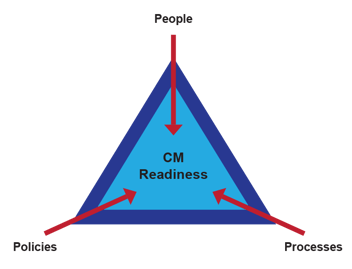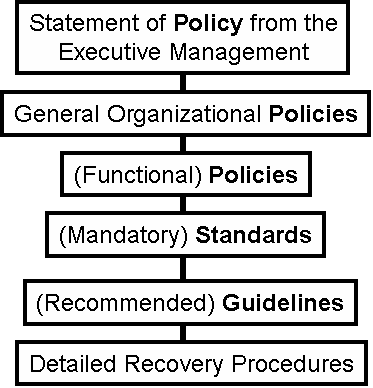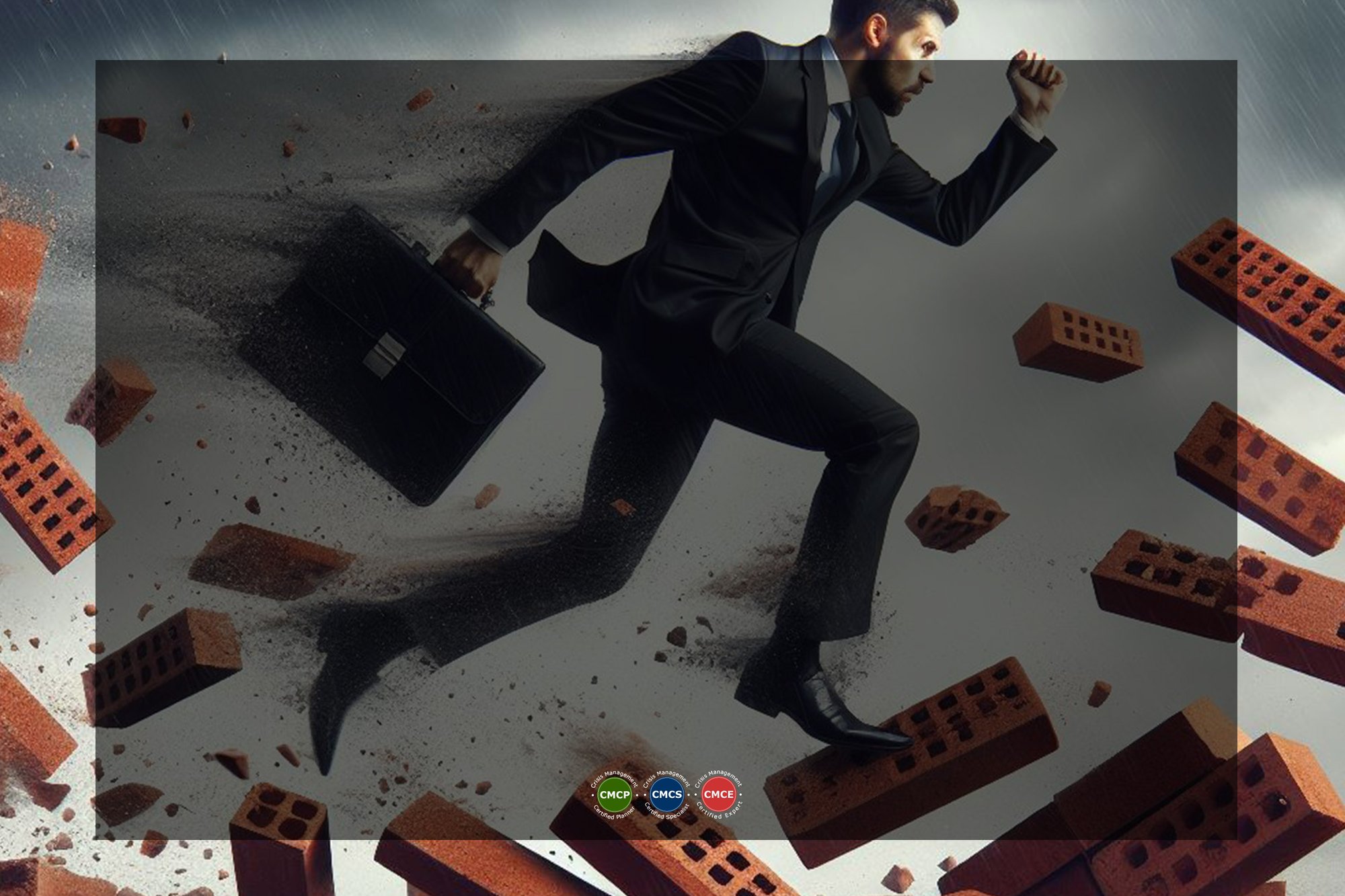Develop CM Planning Framework
![]() Many organisations I have reviewed have told me that their CM policies enhance or hybridise those of several other organisations.
Many organisations I have reviewed have told me that their CM policies enhance or hybridise those of several other organisations.
I strongly encourage this approach as it minimises the need to reinvent the wheel. However, although most organisations share standard basic CM policies, each must tailor its policies to meet its unique corporate requirements. Framework development begins with a clearly defined strategic vision for crisis management.
Here is a simplified approach to developing the CM framework.
Identify Strategic CM Mission
The strategic mission differs for each organisation, and here are some examples:
- Fulfilling fiduciary responsibilities
- Compliance
- Risk reduction
- Readiness
This is usually derived from a brainstorming exercise with the Executive Management.
The framework is directed by three key components: Policies, Processes, and People. All three elements should be directed towards one agreed-upon CM strategic mission. The example I will provide is “CM Readiness,” or how the organization strives to keep itself prepared for any outages.

Key Components of CM Framework
Framework Components
This is a description of the critical components of a CM framework.
People
In this component, you will attempt to identify the key committees that will manage the CM planning effort. They are the CM Steering Committee and the Working Committee. The key personnel, such as the Chief Executive Officer, the Organisation's CM Coordinator, and the CM Coordinators, will be included.
Policies
Additional policies will be generated under this component. The key CMP policies identified should aim to:
- Create awareness of CMP
- Sustain its effectiveness
- Reinforce its importance within the organisation
Processes
In all the CM planning processes, this key component should focus on the steps to implement the CM plan. These three stages are:
- Pre-crisis
- During crisis
- After crisis
“Drill Down” of CM Framework
Using any one of the critical components as a starting point, identify a PEOPLE-, POLICIES-, or PROCESSES-related requirement that you have considered for your CMP implementation, which is directed towards the CMP strategic mission.

Key Components of CM Framework
- Mission
When the strategic CM mission is to ensure “CM READINESS” within your organization, you will ask, “How does the “PEOPLE” component ensure “READINESS”? - People
Let us use the “ability to contact your staff members (PEOPLE) during an activation of a CM plan.” - Policies
What is the policy to ensure this step is designed to lead to “READINESS”? The policy provides an "adequate decision-making process immediately upon activation.” - Processes
What is the process to ensure that the notification procedures are adequate to meet the mission of “READINESS”? The process will ensure each member has a clear role and responsibilities in executing the CM-assigned tasks. - People
How does each staff member hold an updated list and remain contactable after office hours? Each staff must have an updated list in his or her wallet/purse and a copy at home.
This is an iterative process that continues by asking questions about " people,” “policies,” and” processes.”
The critical components of a CM Framework, People, Policies and Processes, will be documented as policies, standards and guidelines. The definitions of these terms are as follows:
Policy
A policy is a broad statement of principle or intent that presents the Executive Management's position on a particular issue or indicates a strategy, plan, or course of action. Policies are interpreted and supported by appropriate standards.
Standard
A standard is a rule or regulation specifying conduct, a course of action, or a response to a situation. Standards are mandatory for implementing the Executive Management's policy and ensuring uniform compliance.
Standard denotes the benchmark or key performance indicators (KPI) that the CM team members are expected to meet as part of the overall organisation's requirements.
Guideline
A guideline is a statement that recommends or suggests conduct, a course of action, or a response to a given situation. Guidelines should be considered when implementing a new business function, moving to a new facility, or dealing with circumstances that, although outside the scope of a standard, require a prudent response.
Policy Types
The CM “policy” I refer to is specific (or functional) and not an “organisation-wide policy.” Policies generally refer to those distinct from the CM standards and guidelines. The policy hierarchy chart below provides an overview of the types of policies that many Organizational CM Coordinators often find challenging to implement.

Hierarchy of Policies, Standards, and Guidelines
I strongly recommend that policies be considered the first and highest level of documentation, from which the lower-level elements of standards, guidelines, and procedures flow. This order does not imply that policies are more important than the lower elements.
The higher policies, which are the more general policies and statements, should be created first for strategic reasons, and then the more tactical elements can follow.
The first policy is the Statement of Policy from the Executive Management. This is generally a high-level statement of a policy that contains the following:
- An acknowledgement by the Executive Management of the importance of CM planning
- A statement of support for CM implementation throughout the organisation
- A commitment to authorise the definition of the lower level of statements and guidelines
Develop CM Framework
 The development of the CM Framework is immediately followed by a policy directive stating their commitment to CM in general and this project in particular.
The development of the CM Framework is immediately followed by a policy directive stating their commitment to CM in general and this project in particular.
If they agree to this request, the CM planning project will have gained much credibility.
If they disagree, you will at least be forewarned that the Executive Management's support for the CM planning project is lukewarm and that you should proceed cautiously.
Click the icon "Develop CM Framework" for a detailed explanation.
Summing Up ...
A policy statement from the Executive Management is the most critical indication of support for the appointed Organisation CM Coordinator and the organisation's commitment to the CM Program.
CM Project Management StepsClick to find out more about the detailed requirements for each step |
|||||
| Back To | 1 | 2 | 3 | 4 | 5 |
 |
 |
 |
 |
 |
 |
| 6 | 7 | 8 | 9 | 10 | 11 |
 |
 |
 |
 |
 |
 |
Goh, M. H. (2016). A Manager’s Guide to Implement Your Crisis Management Plan. Business Continuity Management Specialist Series (1st ed., p. 192). Singapore: GMH Pte Ltd.
Find out more about Blended Learning CM-300 [CM-3] & CM-5000 [CM-5]
To learn more about the course and schedule, click the buttons below for the CM-3 or CM-300 Crisis Management Implementer course and the CM-5 or CM-5000 Crisis Management Expert Implementer course.
 |
 |
 |
 |
 |
![[BL-CM] [5] Register](https://no-cache.hubspot.com/cta/default/3893111/82024308-16f4-4491-98be-818a882c6286.png) |
 |
Please feel free to send us a note if you have any of these questions to ![Email to Sales Team [BCM Institute]](https://no-cache.hubspot.com/cta/default/3893111/3c53daeb-2836-4843-b0e0-645baee2ab9e.png) |
 |





